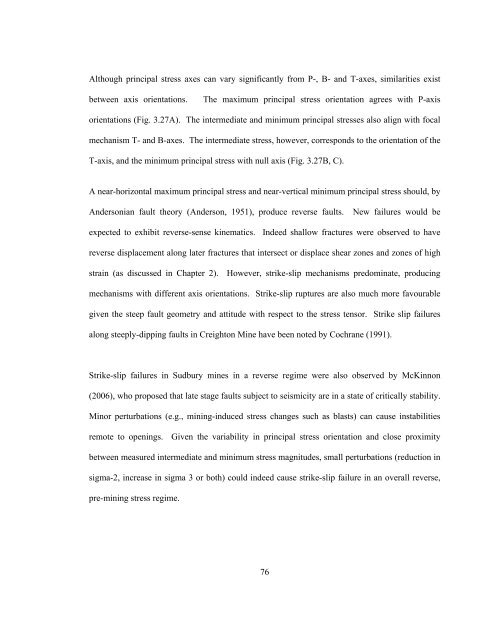title of the thesis - Department of Geology - Queen's University
title of the thesis - Department of Geology - Queen's University
title of the thesis - Department of Geology - Queen's University
Create successful ePaper yourself
Turn your PDF publications into a flip-book with our unique Google optimized e-Paper software.
Although principal stress axes can vary significantly from P-, B- and T-axes, similarities exist<br />
between axis orientations.<br />
The maximum principal stress orientation agrees with P-axis<br />
orientations (Fig. 3.27A). The intermediate and minimum principal stresses also align with focal<br />
mechanism T- and B-axes. The intermediate stress, however, corresponds to <strong>the</strong> orientation <strong>of</strong> <strong>the</strong><br />
T-axis, and <strong>the</strong> minimum principal stress with null axis (Fig. 3.27B, C).<br />
A near-horizontal maximum principal stress and near-vertical minimum principal stress should, by<br />
Andersonian fault <strong>the</strong>ory (Anderson, 1951), produce reverse faults. New failures would be<br />
expected to exhibit reverse-sense kinematics. Indeed shallow fractures were observed to have<br />
reverse displacement along later fractures that intersect or displace shear zones and zones <strong>of</strong> high<br />
strain (as discussed in Chapter 2). However, strike-slip mechanisms predominate, producing<br />
mechanisms with different axis orientations. Strike-slip ruptures are also much more favourable<br />
given <strong>the</strong> steep fault geometry and attitude with respect to <strong>the</strong> stress tensor. Strike slip failures<br />
along steeply-dipping faults in Creighton Mine have been noted by Cochrane (1991).<br />
Strike-slip failures in Sudbury mines in a reverse regime were also observed by McKinnon<br />
(2006), who proposed that late stage faults subject to seismicity are in a state <strong>of</strong> critically stability.<br />
Minor perturbations (e.g., mining-induced stress changes such as blasts) can cause instabilities<br />
remote to openings. Given <strong>the</strong> variability in principal stress orientation and close proximity<br />
between measured intermediate and minimum stress magnitudes, small perturbations (reduction in<br />
sigma-2, increase in sigma 3 or both) could indeed cause strike-slip failure in an overall reverse,<br />
pre-mining stress regime.<br />
76

















